Zhan Gao
Tianyi: A Traditional Chinese Medicine all-rounder language model and its Real-World Clinical Practice
May 19, 2025Abstract:Natural medicines, particularly Traditional Chinese Medicine (TCM), are gaining global recognition for their therapeutic potential in addressing human symptoms and diseases. TCM, with its systematic theories and extensive practical experience, provides abundant resources for healthcare. However, the effective application of TCM requires precise syndrome diagnosis, determination of treatment principles, and prescription formulation, which demand decades of clinical expertise. Despite advancements in TCM-based decision systems, machine learning, and deep learning research, limitations in data and single-objective constraints hinder their practical application. In recent years, large language models (LLMs) have demonstrated potential in complex tasks, but lack specialization in TCM and face significant challenges, such as too big model scale to deploy and issues with hallucination. To address these challenges, we introduce Tianyi with 7.6-billion-parameter LLM, a model scale proper and specifically designed for TCM, pre-trained and fine-tuned on diverse TCM corpora, including classical texts, expert treatises, clinical records, and knowledge graphs. Tianyi is designed to assimilate interconnected and systematic TCM knowledge through a progressive learning manner. Additionally, we establish TCMEval, a comprehensive evaluation benchmark, to assess LLMs in TCM examinations, clinical tasks, domain-specific question-answering, and real-world trials. The extensive evaluations demonstrate the significant potential of Tianyi as an AI assistant in TCM clinical practice and research, bridging the gap between TCM knowledge and practical application.
Sparse Covariance Neural Networks
Oct 02, 2024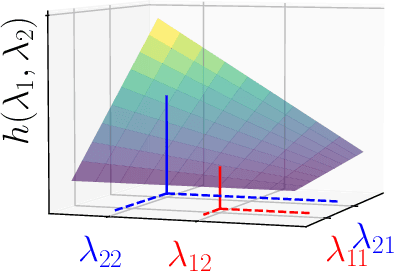



Abstract:Covariance Neural Networks (VNNs) perform graph convolutions on the covariance matrix of tabular data and achieve success in a variety of applications. However, the empirical covariance matrix on which the VNNs operate may contain many spurious correlations, making VNNs' performance inconsistent due to these noisy estimates and decreasing their computational efficiency. To tackle this issue, we put forth Sparse coVariance Neural Networks (S-VNNs), a framework that applies sparsification techniques on the sample covariance matrix before convolution. When the true covariance matrix is sparse, we propose hard and soft thresholding to improve covariance estimation and reduce computational cost. Instead, when the true covariance is dense, we propose stochastic sparsification where data correlations are dropped in probability according to principled strategies. We show that S-VNNs are more stable than nominal VNNs as well as sparse principal component analysis. By analyzing the impact of sparsification on their behavior, we provide novel connections between S-VNN stability and data distribution. We support our theoretical findings with experimental results on various application scenarios, ranging from brain data to human action recognition, and show an improved task performance, stability, and computational efficiency of S-VNNs compared with nominal VNNs.
On LASSO Inference for High Dimensional Predictive Regression
Sep 16, 2024Abstract:LASSO introduces shrinkage bias into estimated coefficients, which can adversely affect the desirable asymptotic normality and invalidate the standard inferential procedure based on the $t$-statistic. The desparsified LASSO has emerged as a well-known remedy for this issue. In the context of high dimensional predictive regression, the desparsified LASSO faces an additional challenge: the Stambaugh bias arising from nonstationary regressors. To restore the standard inferential procedure, we propose a novel estimator called IVX-desparsified LASSO (XDlasso). XDlasso eliminates the shrinkage bias and the Stambaugh bias simultaneously and does not require prior knowledge about the identities of nonstationary and stationary regressors. We establish the asymptotic properties of XDlasso for hypothesis testing, and our theoretical findings are supported by Monte Carlo simulations. Applying our method to real-world applications from the FRED-MD database -- which includes a rich set of control variables -- we investigate two important empirical questions: (i) the predictability of the U.S. stock returns based on the earnings-price ratio, and (ii) the predictability of the U.S. inflation using the unemployment rate.
Co-Optimization of Environment and Policies for Decentralized Multi-Agent Navigation
Mar 21, 2024Abstract:This work views the multi-agent system and its surrounding environment as a co-evolving system, where the behavior of one affects the other. The goal is to take both agent actions and environment configurations as decision variables, and optimize these two components in a coordinated manner to improve some measure of interest. Towards this end, we consider the problem of decentralized multi-agent navigation in cluttered environments. By introducing two sub-objectives of multi-agent navigation and environment optimization, we propose an $\textit{agent-environment co-optimization}$ problem and develop a $\textit{coordinated algorithm}$ that alternates between these sub-objectives to search for an optimal synthesis of agent actions and obstacle configurations in the environment; ultimately, improving the navigation performance. Due to the challenge of explicitly modeling the relation between agents, environment and performance, we leverage policy gradient to formulate a model-free learning mechanism within the coordinated framework. A formal convergence analysis shows that our coordinated algorithm tracks the local minimum trajectory of an associated time-varying non-convex optimization problem. Extensive numerical results corroborate theoretical findings and show the benefits of co-optimization over baselines. Interestingly, the results also indicate that optimized environment configurations are able to offer structural guidance that is key to de-conflicting agents in motion.
On the Trade-Off between Stability and Representational Capacity in Graph Neural Networks
Dec 04, 2023Abstract:Analyzing the stability of graph neural networks (GNNs) under topological perturbations is key to understanding their transferability and the role of each architecture component. However, stability has been investigated only for particular architectures, questioning whether it holds for a broader spectrum of GNNs or only for a few instances. To answer this question, we study the stability of EdgeNet: a general GNN framework that unifies more than twenty solutions including the convolutional and attention-based classes, as well as graph isomorphism networks and hybrid architectures. We prove that all GNNs within the EdgeNet framework are stable to topological perturbations. By studying the effect of different EdgeNet categories on the stability, we show that GNNs with fewer degrees of freedom in their parameter space, linked to a lower representational capacity, are more stable. The key factor yielding this trade-off is the eigenvector misalignment between the EdgeNet parameter matrices and the graph shift operator. For example, graph convolutional neural networks that assign a single scalar per signal shift (hence, with a perfect alignment) are more stable than the more involved node or edge-varying counterparts. Extensive numerical results corroborate our theoretical findings and highlight the role of different architecture components in the trade-off.
An Improved Neural Network Model Based On CNN Using For Fruit Sugar Degree Detection
Nov 18, 2023



Abstract:Artificial Intelligence(AI) widely applies in Image Classification and Recognition, Text Understanding and Natural Language Processing, which makes great progress. In this paper, we introduced AI into the fruit quality detection field. We designed a fruit sugar degree regression model using an Artificial Neural Network based on spectra of fruits within the visible/near-infrared(V/NIR)range. After analysis of fruit spectra, we innovatively proposed a new neural network structure: low layers consist of a Multilayer Perceptron(MLP), a middle layer is a 2-dimensional correlation matrix layer, and high layers consist of several Convolutional Neural Network(CNN) layers. In this study, we used fruit sugar value as a detection target, collecting two fruits called Gan Nan Navel and Tian Shan Pear as samples, doing experiments respectively, and comparing their results. We used Analysis of Variance(ANOVA) to evaluate the reliability of the dataset we collected. Then, we tried multiple strategies to process spectrum data, evaluating their effects. In this paper, we tried to add Wavelet Decomposition(WD) to reduce feature dimensions and a Genetic Algorithm(GA) to find excellent features. Then, we compared Neural Network models with traditional Partial Least Squares(PLS) based models. We also compared the neural network structure we designed(MLP-CNN) with other traditional neural network structures. In this paper, we proposed a new evaluation standard derived from dataset standard deviation(STD) for evaluating detection performance, validating the viability of using an artificial neural network model to do fruit sugar degree nondestructive detection.
Limited-Memory Greedy Quasi-Newton Method with Non-asymptotic Superlinear Convergence Rate
Jun 27, 2023



Abstract:Non-asymptotic convergence analysis of quasi-Newton methods has gained attention with a landmark result establishing an explicit superlinear rate of O$((1/\sqrt{t})^t)$. The methods that obtain this rate, however, exhibit a well-known drawback: they require the storage of the previous Hessian approximation matrix or instead storing all past curvature information to form the current Hessian inverse approximation. Limited-memory variants of quasi-Newton methods such as the celebrated L-BFGS alleviate this issue by leveraging a limited window of past curvature information to construct the Hessian inverse approximation. As a result, their per iteration complexity and storage requirement is O$(\tau d)$ where $\tau \le d$ is the size of the window and $d$ is the problem dimension reducing the O$(d^2)$ computational cost and memory requirement of standard quasi-Newton methods. However, to the best of our knowledge, there is no result showing a non-asymptotic superlinear convergence rate for any limited-memory quasi-Newton method. In this work, we close this gap by presenting a limited-memory greedy BFGS (LG-BFGS) method that achieves an explicit non-asymptotic superlinear rate. We incorporate displacement aggregation, i.e., decorrelating projection, in post-processing gradient variations, together with a basis vector selection scheme on variable variations, which greedily maximizes a progress measure of the Hessian estimate to the true Hessian. Their combination allows past curvature information to remain in a sparse subspace while yielding a valid representation of the full history. Interestingly, our established non-asymptotic superlinear convergence rate demonstrates a trade-off between the convergence speed and memory requirement, which to our knowledge, is the first of its kind. Numerical results corroborate our theoretical findings and demonstrate the effectiveness of our method.
Differentially Private Decentralized Deep Learning with Consensus Algorithms
Jun 24, 2023

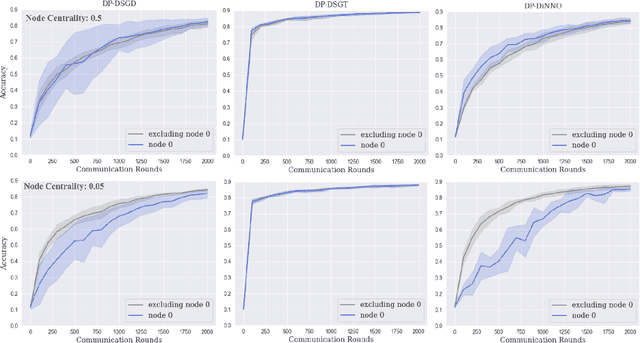
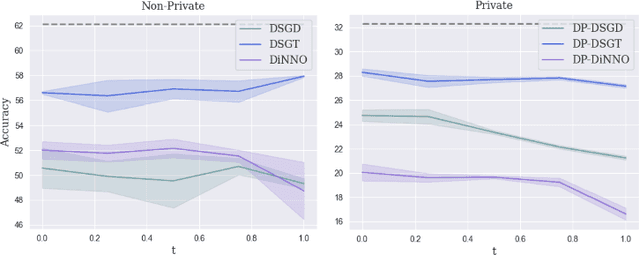
Abstract:Cooperative decentralized deep learning relies on direct information exchange between communicating agents, each with access to a local dataset which should be kept private. The goal is for all agents to achieve consensus on model parameters after training. However, sharing parameters with untrustworthy neighboring agents could leak exploitable information about local datasets. To combat this, we introduce differentially private decentralized learning that secures each agent's local dataset during and after cooperative training. In our approach, we generalize Differentially Private Stochastic Gradient Descent (DP-SGD) -- a popular differentially private training method for centralized deep learning -- to practical subgradient- and ADMM-based decentralized learning methods. Our algorithms' differential privacy guarantee holds for arbitrary deep learning objective functions, and we analyze the convergence properties for strongly convex objective functions. We compare our algorithms against centrally trained models on standard classification tasks and evaluate the relationships between performance, privacy budget, graph connectivity, and degree of training data overlap among agents. We find that differentially private gradient tracking is resistant to performance degradation under sparse graphs and non-uniform data distributions. Furthermore, we show that it is possible to learn a model achieving high accuracies, within 3% of DP-SGD on MNIST under (1, 10^-5)-differential privacy and within 6% of DP-SGD on CIFAR-100 under (10, 10^-5)-differential privacy, without ever sharing raw data with other agents. Open source code can be found at: https://github.com/jbayrooti/dp-dec-learning.
Spectrum Sharing between High Altitude Platform Network and Terrestrial Network: Modeling and Performance Analysis
Jun 08, 2023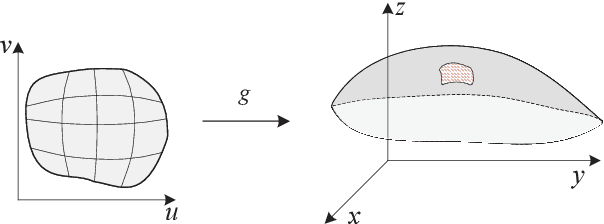
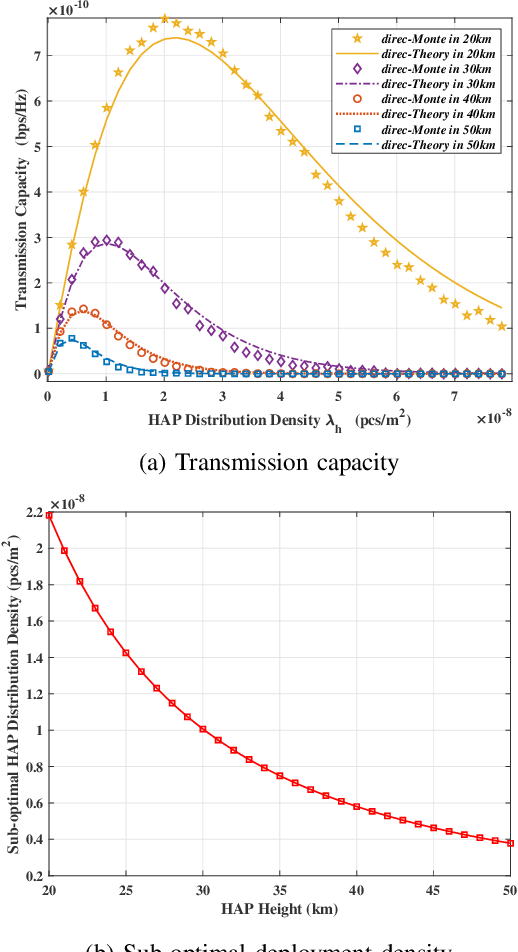
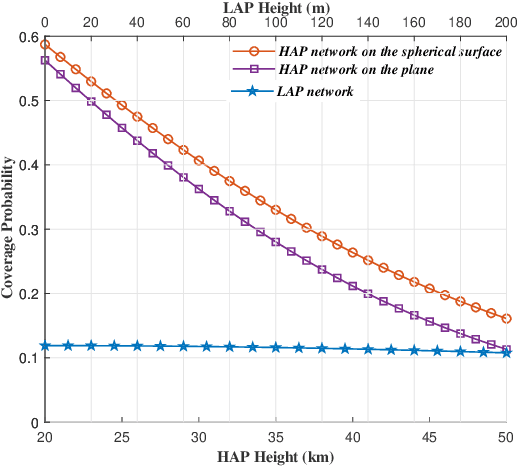
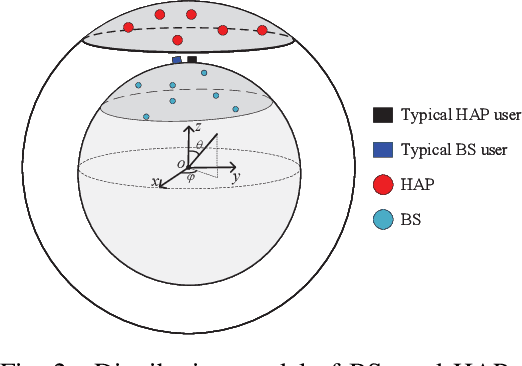
Abstract:Achieving seamless global coverage is one of the ultimate goals of space-air-ground integrated network, as a part of which High Altitude Platform (HAP) network can provide wide-area coverage. However, deploying a large number of HAPs will lead to severe congestion of existing frequency bands. Spectrum sharing improves spectrum utilization. The coverage performance improvement and interference caused by spectrum sharing need to be investigated. To this end, this paper analyzes the performance of spectrum sharing between HAP network and terrestrial network. We firstly generalize the Poisson Point Process (PPP) to curves, surfaces and manifolds to model the distribution of terrestrial Base Stations (BSs) and HAPs. Then, the closed-form expressions for coverage probability of HAP network and terrestrial network are derived based on differential geometry and stochastic geometry. We verify the accuracy of closed-form expressions by Monte Carlo simulation. The results show that HAP network has less interference to terrestrial network. Low height and suitable deployment density can improve the coverage probability and transmission capacity of HAP network.
Constrained Environment Optimization for Prioritized Multi-Agent Navigation
May 18, 2023Abstract:Traditional approaches to the design of multi-agent navigation algorithms consider the environment as a fixed constraint, despite the influence of spatial constraints on agents' performance. Yet hand-designing conducive environment layouts is inefficient and potentially expensive. The goal of this paper is to consider the environment as a decision variable in a system-level optimization problem, where both agent performance and environment cost are incorporated. Towards this end, we propose novel problems of unprioritized and prioritized environment optimization, where the former considers agents unbiasedly and the latter accounts for agent priorities. We show, through formal proofs, under which conditions the environment can change while guaranteeing completeness (i.e., all agents reach goals), and analyze the role of agent priorities in the environment optimization. We proceed to impose real-world constraints on the environment optimization and formulate it mathematically as a constrained stochastic optimization problem. Since the relation between agents, environment and performance is challenging to model, we leverage reinforcement learning to develop a model-free solution and a primal-dual mechanism to handle constraints. Distinct information processing architectures are integrated for various implementation scenarios, including online/offline optimization and discrete/continuous environment. Numerical results corroborate the theory and demonstrate the validity and adaptability of our approach.
 Add to Chrome
Add to Chrome Add to Firefox
Add to Firefox Add to Edge
Add to Edge